My favorite fly rod is a 7-foot stretch of 2-weight fiberglass. It’s slow and noodly. Delicate, even.
And when I show people the rod — maybe we’re gearing up on the tailgate, and they see it tucked away in my rod vault — their first reaction is often something like this: “You like those little brookies, huh?”
Well, yes. I do. But that’s not why this piece of glass is my favorite. It’s the rod that serves me best in the places I love to fish most, and it allows me to fish using my favorite method.
Honestly, the size of the fish is immaterial. For some, when confronted with a 6-foot, 6-inch 1-weight at the fly shop, their first reaction is one of confusion. Why chase little fish when we have lots of big fish around these parts?
It’s a logical question. For bigger water where longer casts are necessary — or where being able to high-stick a nymph through a riffle is vital, for instance — most anglers aren’t going to choose a rod shorter than the industry norm of 9 feet. But for intimate quarters where a long cast might be 30 feet, and where shaving two or three feet off the top of the rod gives you a bit of cushion for your backcast, a shorter, lighter rod makes sense. It especially makes sense if you’re going to fish dry flies almost exclusively.
So let’s bust that myth. Shorter, lighter rods aren’t just for shorter, lighter fish. Rather, they’re for tighter conditions on small water where presentation and accuracy matter more than longer casts and the ability to toss bigger flies.
Certainly, lighter fly rods give smaller fish more backbone. No argument there. But, over the years, I’ve caught plenty of big trout using light fly rods. In the remote upper reaches of British Columbia’s Elk River, I caught a dozen 20-inch cutthroats in a single morning using my go-to small-stream dry-fly rod. And no, I didn’t tire fish out unnecessarily — more often than not, that’s a tippet issue, not a rod issue (for backcountry trout that don’t often see flies, there’s almost no reason to go lighter than 3x). I didn’t have to cast more than 40 feet, and what I needed more than heft was a lighter touch and the ability to put a size 12 hopper within an inch of the bank.
You bet … the fights that the fat cutthroats put up were epic — glass has a way of allowing the angler feel every pulse, every shake of the head and every dive a fish makes. But with a deft approach and the aforementioned 3x tippet, the battles ended just as they would have had I chosen a 9-foot length of the latest and greatest graphite.
In general, when choosing a fly rod’s length and weight, it’s best to first consider the type of fly fishing you enjoy. If you’re a drift boat angler, you’d be silly to fish anything shorter than 9 feet. And, because you’ll need bigger flies (streamers, heavy nymphs and big, foam terrestrials), you’ll likely need a heavier rod, like a 5-weight or even a 6-weight if you’re after fish that are deep.
But if you love backcountry trout streams that you might be able to jump across with a running start … where willows line banks instead of tall cottonwoods, and where you may have to climb a spruce tree to retrieve your fly rather than having the person at the oars row the boat to shore so you can unhook an errant cast, you should consider a stick that performs best under the conditions.
And if you love to cast dry flies in tight quarters to willing trout that hide in the densest of root wads and under the deepest cutbanks, a lighter, shorter rod will serve you best. Here’s why:
- Shorter rods for shorter casts require tighter, more compact casts, often just a few feet. And most fly lines designed for shorter, lighter rods are “weight-forward,” meaning the head of the line is where the weight is, so anglers can make those short casts easier with just a few feet of fly line out of the tip.
- There’s less of a footprint. In tight conditions, you’re not going to need to make longer casts. Cutting two or three feet from your rod length cuts two or three feet from your backcast length, reducing the likelihood that you’ll catch branches and bushes with your backcast. But, let’s be honest. If you fish in water that tight, you’ll catch your share of wood. But you might catch less with a shorter rod.
- Everything is compact on small streams, including your cast. If you’re casting 50 or 60 feet on a small stream, chances are, you’re casting over the fish that are in the holding water just a few feet from your ankles. Instead, your casting motion is shortened and compact, and a shorter, lighter rod lends itself to that tighter casting motion. Compare it to golf, if that helps — you wouldn’t use a 3-iron to chip onto the green from the rough, would you? Why use a rod designed to cast 60 feet when the fish are 15 feet away?
- You’ll feel better at the end of the day. And, yes, this is coming from a 50-plus angler. On small streams, you cast more. A lot more. Drifts are shorter. The need to dry flies with false casts can be greater. You’re more active than you are on bigger water, particularly if you fish that big water from a boat. A lighter rod will reduce resistance and reduce the fatigue that can come with repetitive casting.
Are there exceptions to the small stream/small rod rule? Of course. Over the last dozen years or so, I’ve come to appreciate the virtues of longer rods on small water when I’m dapping or nymphing (and if weight is an issue, there are some really solid 9-foot, 3-weight rods on the market today). And I’ve become the angler who also appreciates what a good 12-foot-long tenkara rod can do on small water — there’s something deeply gratifying about having nothing on the water except the fly, with no errant drag to ruin an otherwise good cast.
But, on the whole, a lighter-weight rod is a better choice than a longer, heavier implement. And, no, it’s not because the fish are small (although, in many instances, that is, indeed the case). It’s because the conditions call for a more precise tool. And that’s the beauty of small-stream angling. If you can catch fish on small water and perform all the casts necessary to reach undercut banks and avoid overhanging willows, you can catch fish anywhere, no matter how big they are or how hefty the rod must be. Let the small-stream skeptics stay that way. When you come across that 7-foot 3-weight in the fly shop, just imagine the places it can take you and the fish that it can help you catch. Then look at your buddy who’s shaking their head and muttering about “those little brookies” they think the rod was designed to catch.
Shows you what they know.




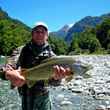
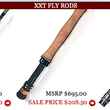





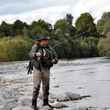


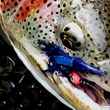





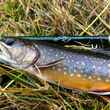



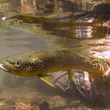
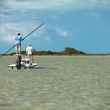



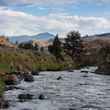

Comments
Eric replied on Permalink
Thanks, Chris. I recently ordered a 3 wt glass rod. Haven't fished with it before, but I'm excited about it. What's the disadvantage to using it for nymphing? Specifically a double nymph rig.
Chris replied on Permalink
Good question, Eric. No disadvantage if it's long enough. With the double-nymph setup, you're going to be casting a longer leader and likely some weight. Longer rods are more suited to this. That said, glass is the bomb ... if you're nymphing up close, you can likely adapt. Enjoy!
Milo replied on Permalink
100%. After going trying down to 0-1 weights when I had a period exclusively on little creeks, my middle go-to for compact water is a 6'6" 3wt graphite soft-medium action. It does the job, reduces hang ups, gets in under the brush. Can throw hoppers and nymphs, And it's intimate and fun!
Ed Maurer replied on Permalink
Great points. My best small rod for tight spaces is an Eagle Claw 6' 3wt. Glass. I know, God forbid I didn't spend hundreds on a rod that so far has performed well above it's social standing. (Frankly, I'd like to see this rod compared to the "expensivist" rods in its category.) I can get under trees (usually!) and make side arm casts when I can't. It works at 20' and at 40' or more. And if I break it, raiding the piggy bank will replace it. Good observations, Chris. Thanks.
matthew housel replied on Permalink
I fish almost exclusively with 7.5 ft 3 and 4wts in the desert for redbands in Southern Idaho and Eastern Oregon. Some of the fish get quite large, up to 20 inches. But because of the amount of bushes and rocks behind you, they are a necessity. They fit where a 9 ft rod does not. I have no problem throwing a double nymph rig with them either. Good write up chris.
Pages